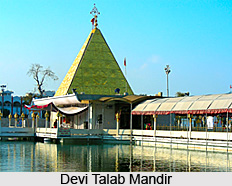 Devi Talab Mandir is one of the ancient temples of Jalandhar. This 200 year old temple is entirely dedicated to Goddess Durga. It is one of the 51 Shakti Peethas in India. It is believed that Sati`s right breast fell here. Lord Shiva in this temple is known as Bhishan Bhairav. Devi Talab Mandir got its name from the huge tank present in the temple complex. The tank is as old as the main temple and is one of the main attractions of the premise.
Devi Talab Mandir is one of the ancient temples of Jalandhar. This 200 year old temple is entirely dedicated to Goddess Durga. It is one of the 51 Shakti Peethas in India. It is believed that Sati`s right breast fell here. Lord Shiva in this temple is known as Bhishan Bhairav. Devi Talab Mandir got its name from the huge tank present in the temple complex. The tank is as old as the main temple and is one of the main attractions of the premise.
Location of Devi Talab Mandir
The temple is located exactly in the heart of Jalandhar which is situated in the Punjab state of India. Jalandhar, previously known as Jullundur, is an ancient city of Punjab. It has its existence before the time of Mahabharata. In times of the Mahabharatawar, it was the capital of `Trigarttas`, meaning "land between three rivers".
Significance of Devi Talab Mandir
The significance of the place is for the old temple of Goddess Kali, which stands by the side of this temple. Here the Goddess Kali is known by the name of Tripurmalini.
Mythology of Devi Talab Mandir
According to legends and history, this temple is associated with Maa Sati and her sacrifice. It is believed that Maa Sati sacrificed herself after her own father Daksha had insulted her husband Lord Shiva. Shiva then opened his third eye in anguish and did tandav with Maa Sati"s body in his arms. Owing to the fear of Lord Shiva"s anger and in order to save the Universe, Lord Vishnu dispatched his "Sudarshan Chakra". As a consequence, Sati"s body was cut into pieces scattering on earth. Each of the places where Ma Sati"s pieces fell were blessed and honoured. These very places are known as Shakti Peethas. This place received Maa Sati"s right breast.
Renovation of Devi Talab Mandir
The Devi Talab Mandir has undergone renovation and new sections have been added within the temple premises. A new temple has been built in its centre. Recently, a structure resembling the Amarnath Cave Temple has been built in the premises.
Connectivity of Devi Talab Mandir
The ideal time to visit this temple is in the month of December. During this month, the famous "Harballabh Sangeet Sammelan" is organised. The nearest railway station is Jalandhar railway station.





















